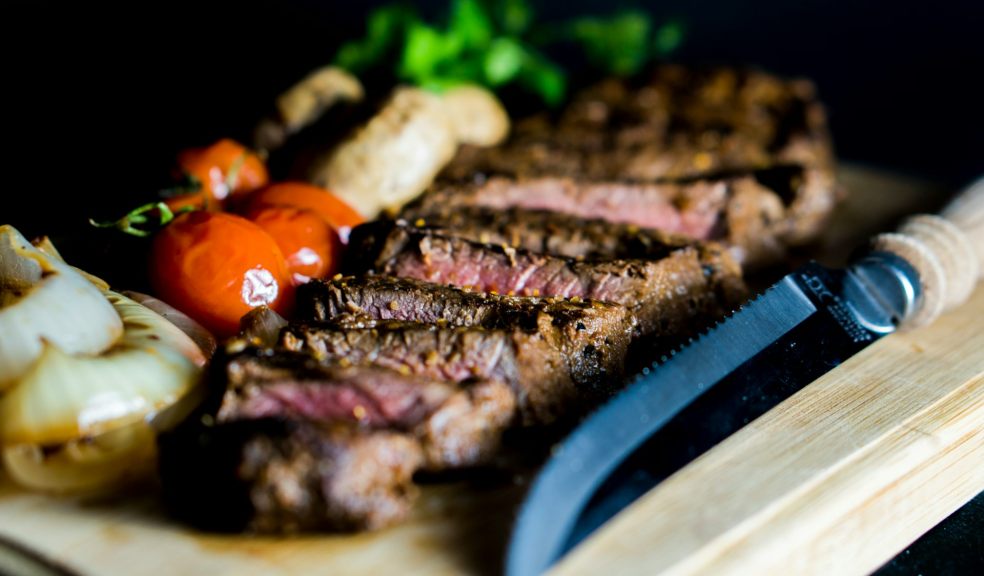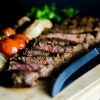
Mastering the Science of Grilling the Perfect Steak
Grilling the perfect steak is both a sensory experience and a scientific process. It’s about knowing your ingredients, controlling heat, and applying the right techniques to achieve that perfect balance of tenderness, flavor, and texture.
Whether you're a grilling novice or a seasoned expert, understanding the techniques and tools, such as using the Typhur meat thermometer, can make all the difference. Grilling a steak isn’t just about throwing a piece of meat on a hot surface—it’s about precision, temperature control, and timing.
Understanding Steak Cuts and Their Unique Characteristics
Ribeye, Filet Mignon, Strip, and Sirloin: What’s the Difference?
Each cut has its strengths. Ribeye offers intense marbling, creating a flavorful, juicy bite. Filet mignon, by contrast, is lean and exceptionally tender, perfect for those seeking a buttery texture. New York strip provides a more robust, firm chew, while sirloin balances affordability with flavor, making it an excellent option for casual grilling. Choosing the right cut depends on your preference for texture and fat content.
Fat Content vs. Flavor: How Marbling Impacts Taste and Texture
Marbling refers to the fat dispersed within the muscle, which melts during grilling, basting the steak from within. Cuts with more marbling, like ribeye, retain moisture and develop deeper flavors. Leaner cuts such as filet mignon require precise cooking to avoid drying out since they lack the fat content that adds flavor.
But knowing your cut is only half the battle—what happens next on the grill transforms these cuts into something extraordinary.
The Science of the Maillard Reaction
Once your steak hits the grill, science takes over.
The Maillard reaction occurs when heat causes proteins and sugars on the steak’s surface to break down and recombine into new, flavorful compounds. This is what gives grilled steak its signature brown crust and mouthwatering aroma.
For the Maillard reaction to occur effectively, the surface temperature of the steak must exceed 300°F (149°C). This process delivers not only texture but also complex, savory notes that elevate the meat's flavor
The Role of Temperature in Steak Grilling
Steak doneness relies on precise internal temperatures:
- Rare: 125°F (52°C) – Cool red center
- Medium-Rare: 135°F (57°C) – Warm red center
- Medium: 145°F (63°C) – Warm pink center
- Well-Done: 160°F (71°C) – No pink, fully cooked
Grilling to the perfect temperature requires attention, as overcooking can cause the meat to dry out. Using a meat thermometer helps avoid guesswork. Check our favorite instant read thermometer here.
Starting with a room-temperature steak ensures it cooks more evenly. A cold steak on the grill often results in an overdone exterior and an undercooked center. Resting the meat outside the fridge for 30-45 minutes allows it to come to room temperature, improving both cooking time and final results.
Once the steak comes off the grill, let it rest for at least 5-10 minutes. This allows the juices to redistribute within the meat, preventing them from spilling out when sliced. Resting ensures every bite is juicy and flavorful.
Best Meat Thermometer for Grilling Steak
If you’re serious about nailing the perfect steak, a meat thermometer is non-negotiable. I love using wireless meat thermometers when grilling thicker cuts like ribeye—monitoring the temperature remotely means I don’t have to keep opening the grill and lose heat. On the other hand, for quick sears or thinner steaks, the Typhur meat thermometer is my go-to. It gives me an accurate reading in seconds, so I can pull the steak off the heat at the perfect moment.
How to Grilling the Perfect Steak
Preparing Your Steak
Preparation is just as important as the actual grilling process. Here are a few tips to get your steak grill-ready:
- Bring Steak to Room Temperature: Before placing the steak on the grill, allow it to sit out for 30 minutes to an hour. This ensures that the meat cooks evenly.
- Season Generously: A good steak doesn’t need much in the way of seasoning. A generous sprinkle of salt and pepper is often enough to enhance the meat's natural flavors. Some people also like to add garlic, rosemary, or other herbs for added depth.
- Pat the Steak Dry: Moisture is the enemy of a great sear. Pat your steak dry with a paper towel to remove any excess moisture from the surface. This will help create that beautiful crust when the steak hits the grill.
Grilling
Grilling a steak is all about heat management. Here’s a step-by-step guide to grilling your steak to perfection:
1. Preheat the Grill
Get your grill nice and hot. For steaks, you’ll want to aim for high heat—around 450°F to 500°F. Preheating ensures that the steak will sear properly, locking in the juices.
2. Sear the Steak
Place your steak directly over the hottest part of the grill. The goal here is to develop a deep, caramelized crust on both sides. Depending on the thickness of the steak, this should take about 3-4 minutes per side.
3. Monitor the Temperature
This is where the best meat thermometer becomes essential. Once both sides have a good sear, move the steak to a cooler part of the grill and continue cooking until it reaches your desired internal temperature. Here’s a quick guide to steak doneness based on internal temperature:
- Rare: 120°F to 125°F
- Medium-Rare: 130°F to 135°F
- Medium: 140°F to 145°F
- Medium-Well: 150°F to 155°F
- Well-Done: 160°F and above
Insert the thermometer into the thickest part of the steak to get an accurate reading, being careful not to hit the bone (if applicable), which can throw off the reading.
4. Rest the Steak
Once the steak reaches your desired temperature, remove it from the grill and let it rest for 5 to 10 minutes. Resting allows the juices to redistribute throughout the steak, ensuring a juicy bite with every cut. Skipping this step can lead to dry, tough meat.
Common Grilling Mistakes to Avoid
While grilling steak may seem straightforward, a few common mistakes can easily ruin your meal. Here are some pitfalls to avoid:
- Not using a meat thermometer: As mentioned earlier, guessing the internal temperature of your steak based on time or feel is a recipe for disaster. Using the best meat thermometer eliminates the risk of overcooking or undercooking your steak.
- Flipping too often: Resist the urge to constantly flip your steak. Ideally, you should only flip it once to achieve that perfect sear and allow the meat to cook evenly.
- Pressing down on the steak: Pressing on the steak with a spatula or fork forces the juices out, leaving you with a dry steak. Let the grill do the work.
- Not preheating the grill: A cold grill will cause the steak to cook unevenly and prevent that crisp, flavorful crust from forming.
The Science Behind the Perfect Steak
Grilling steak isn’t just about technique—it’s also about understanding the science of meat. As the steak cooks, the proteins in the meat denature, and the fat melts, creating the rich flavor we associate with a perfectly grilled steak. The Maillard reaction, a chemical process that occurs when the steak is seared, is responsible for that delicious brown crust and smoky flavor. Mastering the balance between these processes, with the help of a meat thermometer, allows you to control the final texture and taste of your steak.
Conclusion
Grilling the perfect steak is a balance of art and science, requiring a careful mix of heat control, timing, and technique. By using the best meat thermometer, you can take the guesswork out of the process and ensure your steak reaches the ideal internal temperature for your desired doneness.
Whether you prefer your steak rare, medium, or well-done, precision is key. And with the right preparation, the best tools, and a solid understanding of how meat behaves under heat, you’ll be able to master the art of grilling the perfect steak every time. So, fire up the grill, grab your thermometer, and get ready to enjoy a steak that’s cooked to perfection.

















